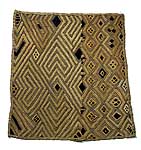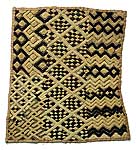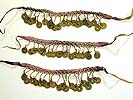This page is a record of an exhibit that took place in 2003. The individual links below will take you to the CURRENT VERSION of the pages that formed part of that exhibit. |
Our spring exhibit, African Currency, focuses on the wonderful variety of metal objects used in traditional Africa to trade and store wealth. These pieces might be used for major purchases (of land or animals) or to signify a transfer of wealth at major events, such as birth, coming of age, marriage, or death. The most frequent use was as bridewealth, to compensate a family for the loss of a daughter.
Most forms were developed from traditional metal objects that were already in use such as weapons, tools, bracelets and anklets. While some continued to be functional for work or decorative purposes, most evolved into "pure" currency, deliberately unusable except as objects recognized, prized and accepted widely as payment.
The objects displayed range in size from small cowrie shells, trade beads, Asante goldweights and iron Kissi pennies to large Tarumba spears, Fulani posts and Afo hoe money. Objects can be crude, such as Mumuye bars or refined and elegant, such as Kwele anchors or Baule, Ekonda and Mbole anklets. There are simple shapes such as Mambila and northern Nigerian hoes and complex Igbo coils and assembled pieces like the money belts, money trees and gongs of the Yoruba people.
We have famous classic forms such as manillas, Katanga crosses and Bangala speartips as well as lesser known Poto, Pakudo and Kuba knife or sword currencies, Lobi snakes and Kusu bolokos. A diverse group of Fang throwing knives, Mangbetu trombash, Mfunte blades, Idoma, Toma and Tuareg pieces complete our display of technically impressive and beautifully wrought pieces. Each displays the artisan's love for the material and the desire to make artifacts worth preserving. Our metal currencies are old, mostly 19th century, and are forged iron, cast or hammered copper or other alloys. The metal pieces are complemented by a wall of Kuba Shoowa raffia textiles which were also traded and stored as money.
These massive ( 5.5 -10 lbs.) iron forms were used by the Afo people of No. Nigeria. They were recognized and used as currency for major transactions.
AKAN, BRACELET CURRENCY, Ghana
"Bracelet" Currency, Ghana. These copper alloy forms were recognized and used to store and transfer wealth.

"Potato Masher" Currency, Gabon. These heavy iron forms were recognized and used as currency for rare but major transactions.
BAMUN, BRACELET CURRENCY, Cameroon
"Bracelet" Currency, Cameroon. These intricate copper alloy forms, made by the lost wax process, were recognized and used as currency for rare but major purposes.



BANGALA, SPEARTIP CURRENCY, Dem. Rep. Congo
"Spear tip" currency, Dem. Rep. Congo. These iron "weapons" were recognized and used as currency for rare but major transactions.
BASSA, ANKLET CURRENCY, Liberia
"Anklet" Currency, Liberia. These copper alloy forms were recognized and used as currency for rare but major transactions.
BAULE, BRACELET CURRENCY, Ivory Coast
"Anklet" Currency, Ivory Coast. These copper alloy forms, made by the lost wax process, were recognized and used to store and transfer wealth.
These iron forms were recognized and used as currency.
EKONDA, ANKLET CURRENCY, Dem. Rep. Congo
These copper alloy forms were recognized and used as currency for rare but major transactions.
These iron forms were recognized and used as currency for rare but major transactions. The necklaces use British West African coins as decorative and prestige items.
GURUNSI, BRACELET CURRENCY, Burkina Faso
This beautiful "bracelet" currency was recognized and used for rare but major transactions. It was placed on a special woven base, which is included.
These large iron forms were made to resemble a tool, with a long "handle".
These iron forms were recognized and used as currency. If not hung, the pieces can be mounted on bases as above.
These copper alloy "coiled bracelet" forms were recognized and used as currency. The staffs were used for status and storage of wealth.
KATANGA, "CROSS" CURRENCY, Dem. Rep. Congo
These cast iron forms were recognized and used as currency. The texture derives from the flowing of the metal into a simple earthen mold.
KIRDI, CURRENCY, Cameroon
These iron forms were recognized and used as currency.
KISSI, "PENNY" CURRENCY, Sierra Leone
These plant-like iron forms were recognized and used as currency for minor transactions



KUBA, SHOOWA RAFFIA TEXTILE CURRENCY, Dem. Rep. Congo
These textiles were highly prized and were accepted as currency. One could accumulate wealth and prestige by collecting quantities of them. At funerals they would be displayed as a record of success. They could be passed on or buried with the body to help provide for it in the afterlife.
KUSU, "U" CURRENCY, Dem. Rep. Congo
These simple iron U-shaped forms, called "Boloko", were recognized and used as currency.



KWELE, "ANCHOR" CURRENCY, Gabon
These elegant iron shaped forms were recognized and used as currency for rare but major transactions.
MAMBILA, "HOE" CURRENCY, Cameroon
These iron "tools" similar to hoes, were recognized and used as currency
MANILLA, CURRENCY, West Africa
These copper alloy "bracelet" forms were recognized and used as currency for transactions in West Africa from the end of the 15th C. to the mid-20th C. The metal content varies from copper to brass, but many were mixed with lead and even iron. The natives valued them by their ring when struck.
MBOLE, ANKLET CURRENCY ARCHIVES, Dem. Rep. Congo
These copper "anklet" forms were recognized and used as currency. They can be exhibited on their own or on stands that allow them to be rotated to any angle.



MFUNTE, BLADE CURRENCY, Nigeria
These iron "weapons" were recognized and used as currency for rare but major transactions. Although similar, the sizes and patinas vary slightly.
These three different iron forms were recognized and used as currency.

NO. NIGERIAN, CURRENCY, Nigeria
These iron or brass forms were used by several peoples of No. Nigeria and Cameroon, including the Chamba, Mumuye, Mambila, Idoma, Matakam and Montol.

NIGERIAN "HOE" CURRENCY, Nigeria
These iron "tools" were recognized and used as currency for rare but major transactions with several peoples of what is now Nigeria.
TOPOKE, "SPEAR" CURRENCY, Dem. Rep. Congo
These iron shaped "weapons" and blades were recognized and used as currency for rare but major transactions. They are much too thin to have ever been intended as functional weapons and are not sharp.
These brass forms were recognized and used as currency. They take the form of unclosed bracelets.
These iron forms were recognized and used as currency. They are larger but similar to the nearby Kissi people's "pennies".
The Tuareg, nomads who travel all over the Sahara desert are primarily herders and traders. Skilled craftsmen made elegant forms from brass and silver metals, most were worn as jewelry and were the principal method of storing and exchanging wealth.
These rough iron forms were recognized and used as currency.
YORUBA, MONEY TREE CURRENCY, Nigeria
These metal forms were made to hold a set number of coins, usually from British West Africa, to make an object of tradeable value.This form was recognized and used as currency and could be broken up for smaller transactions.
YORUBA, MONEY BELT CURRENCY, Nigeria
These brass rings were tied together with a leather snake-like spine and worn as a belt. This form was recognized and used as currency and could be broken up for smaller transactions. The belts are indistinguishable except by how they are arranged.
YORUBA, CURRENCY OBJECTS, Nigeria
These unique objects were made from guords to hold a set of coins, usually from British West Africa, to make an object of tradeable value and prestige.
GO TO AFRICAN METALWORKS 2 EXHIBITION PAGE
TRIBE |
OBJECT |
MJM02272017